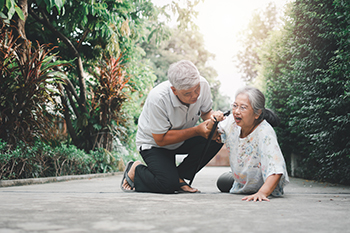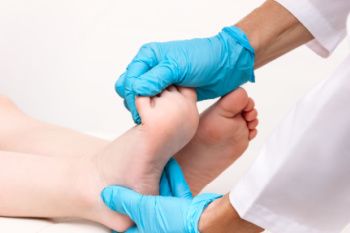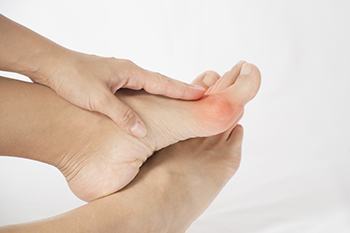Merrillville, IN
Munster, IN
February 2024
Foot Pain and Falls in the Elderly

Foot pain affects up to 30 percent of older adults. This discomfort not only diminishes their overall health but also contributes to impaired balance and reduced physical function. The result is an increased risk of falls. Studies show that the link between foot pain and falls becomes increasingly significant with age. More than a third of those aged 65 and above experience a fall at least once a year, a percentage that rises to over 40 percent for those 75 and older. Recurrent falls are particularly common among individuals suffering from severe foot pain, and certain foot postures, such as flat feet, are linked to a higher risk of falls. By addressing foot pain and taking measures to improve foot function and posture, older adults can lower the risk of falls. For help with foot pain and its related risk of falling, it is suggested that you make an appointment with a podiatrist for an evaluation and guidance.
Preventing falls among the elderly is very important. If you are older and have fallen or fear that you are prone to falling, consult with Ahmad Elsamad, DPM from The Institute of Foot & Ankle Reconstructive Surgery . Our doctor will assess your condition and provide you with quality advice and care.
Every 11 seconds, an elderly American is being treated in an emergency room for a fall related injury. Falls are the leading cause of head and hip injuries for those 65 and older. Due to decreases in strength, balance, senses, and lack of awareness, elderly persons are very susceptible to falling. Thankfully, there are a number of things older persons can do to prevent falls.
How to Prevent Falls
Some effective methods that older persons can do to prevent falls include:
- Enrolling in strength and balance exercise program to increase balance and strength
- Periodically having your sight and hearing checked
- Discuss any medications you have with a doctor to see if it increases the risk of falling
- Clearing the house of falling hazards and installing devices like grab bars and railings
- Utilizing a walker or cane
- Wearing shoes that provide good support and cushioning
- Talking to family members about falling and increasing awareness
Falling can be a traumatic and embarrassing experience for elderly persons; this can make them less willing to leave the house, and less willing to talk to someone about their fears of falling. Doing such things, however, will increase the likelihood of tripping or losing one’s balance. Knowing the causes of falling and how to prevent them is the best way to mitigate the risk of serious injury.
If you have any questions, please feel free to contact our offices located in Merrillville, and Munster, IN . We offer the newest diagnostic and treatment technologies for all your foot care needs.
Insights Into Hammertoe

Hammertoe, a prevalent foot deformity, manifests as an abnormal bending of the toe joints, causing toes to resemble a hammer's shape. This condition typically affects the second, third, or fourth toe, resulting from an imbalance in the muscles, tendons, and ligaments that control toe movement. Common causes of hammertoe include wearing ill-fitting shoes, toe injuries, and underlying foot conditions like arthritis or bunions. Over time, hammertoes can become rigid and painful, making walking and wearing shoes uncomfortable. Recognizing the signs, such as toe stiffness, corns, or calluses, is vital for early intervention and treatment. While conservative measures like wearing roomy shoes, toe exercises, and padding can alleviate symptoms, severe cases may require surgical correction to realign the toe joints and restore functionality. With proper care and attention, individuals can manage hammertoe effectively, minimizing discomfort and maintaining optimal foot health. If you have developed hammertoe, it is strongly suggested that you consult a podiatrist who can determine what the best course of treatment is for you.
Hammertoes can be a painful condition to live with. For more information, contact Ahmad Elsamad, DPM of The Institute of Foot & Ankle Reconstructive Surgery . Our doctor will answer any of your foot- and ankle-related questions.
Hammertoe
Hammertoe is a foot deformity that occurs due to an imbalance in the muscles, tendons, or ligaments that normally hold the toe straight. It can be caused by the type of shoes you wear, your foot structure, trauma, and certain disease processes.
Symptoms
- Painful and/or difficult toe movement
- Swelling
- Joint stiffness
- Calluses/Corns
- Physical deformity
Risk Factors
- Age – The risk of hammertoe increases with age
- Sex – Women are more likely to have hammertoe compared to men
- Toe Length – You are more likely to develop hammertoe if your second toe is longer than your big toe
- Certain Diseases – Arthritis and diabetes may make you more likely to develop hammertoe
Treatment
If you have hammertoe, you should change into a more comfortable shoe that provides enough room for your toes. Exercises such as picking up marbles may strengthen and stretch your toe muscles. Nevertheless, it is important to seek assistance from a podiatrist in order to determine the severity of your hammertoe and see which treatment option will work best for you.
If you have any questions, please feel free to contact our offices located in Merrillville, and Munster, IN . We offer the newest diagnostic and treatment technologies for all your foot care needs.
Common Conditions Affecting Children’s Feet

Children can develop various foot conditions like adults, including plantar warts, flat feet, heel pain, and ingrown toenails. However, these issues can have unique characteristics in children due to their growing bodies and active lifestyles. Normal bone and muscle growth changes in the legs during childhood can contribute to heel pain and flat feet. Additionally, children's active nature can lead to common problems like ingrown toenails and warts, often worsened by wearing tight-fitting shoes during growth spurts. Ingrown toenails can affect people of all ages but are prevalent among teenagers, possibly due to ill-fitting footwear, and resulting in infected ingrown toenails causing the skin to become red, swollen, and warm. Plantar warts, caused by a virus, often appear in children and young adults, resembling circular, thickened skin with tiny black dots. Flat feet, or pes planus, are common among children, generally resolving naturally but manageable with orthotics or arch supports to control pronation. Heel pain in children often relates to plantar fasciitis or Sever's disease, triggered by tight calf muscles and Achilles tendons during growth spurts. If your child has foot problems, it is suggested that you schedule an appointment with a podiatrist for a proper diagnosis and appropriate treatment for their situation. Early identification is important in ensuring children have healthy and pain-free feet as they grow and develop.
The health of a child’s feet is vital to their overall well-being. If you have any questions regarding foot health, contact Ahmad Elsamad, DPM of The Institute of Foot & Ankle Reconstructive Surgery . Our doctor can provide the care you need to keep you pain-free and on your feet.
Tips for Keeping Children's Feet Healthy
- Make sure their shoes fit properly
- Look for any signs of in-toeing or out-toeing
- Check to see if they have Clubfoot (condition that affects your child’s foot and ankle, twisting the heel and toes inward) which is one of the most common nonmajor birth defects.
- Lightly cover your baby’s feet (Tight covers may keep your baby from moving their feet freely, and could prevent normal development)
- Allow your toddler to go shoeless (Shoes can be restricting for a young child’s foot)
- Cut toenails straight across to avoid ingrown toenails
- Keep your child’s foot clean and dry
- Cover cuts and scrapes. Wash any scratches with soap and water and cover them with a bandage until they’ve healed.
If you have any questions, please feel free to contact our offices located in Merrillville, and Munster, IN . We offer the newest diagnostic and treatment technologies for all your foot care needs.
Who Is Most at Risk to Develop Bunions
 Bunions, bony protrusions at the big toe joints, can develop due to a variety of factors. While there are lifestyle factors that can contribute, you are more likely to develop bunions if they run in the family, and if you have a certain foot structure. Wearing narrow and ill-fitting shoes increases the chance of bunion formation. Other risk factors for bunions include foot injuries, deformities, activities that place repetitive stress on the feet, or conditions such as arthritis. You can take preventive measures against bunion formation, such as wearing comfortable shoes with adequate toe space and low heels. However, if you already have bunions, they cannot be reversed except through surgery. If you are experiencing pain from bunions, or if you want to address potential risks, it is suggested you consult with a podiatrist who can guide you toward an appropriate treatment plan.
Bunions, bony protrusions at the big toe joints, can develop due to a variety of factors. While there are lifestyle factors that can contribute, you are more likely to develop bunions if they run in the family, and if you have a certain foot structure. Wearing narrow and ill-fitting shoes increases the chance of bunion formation. Other risk factors for bunions include foot injuries, deformities, activities that place repetitive stress on the feet, or conditions such as arthritis. You can take preventive measures against bunion formation, such as wearing comfortable shoes with adequate toe space and low heels. However, if you already have bunions, they cannot be reversed except through surgery. If you are experiencing pain from bunions, or if you want to address potential risks, it is suggested you consult with a podiatrist who can guide you toward an appropriate treatment plan.
If you are suffering from bunion pain, contact Ahmad Elsamad, DPM of The Institute of Foot & Ankle Reconstructive Surgery . Our doctor can provide the care you need to keep you pain-free and on your feet.
What Is a Bunion?
Bunions are painful bony bumps that usually develop on the inside of the foot at the joint of the big toe. As the deformity increases over time, it may become painful to walk and wear shoes. Women are more likely to exacerbate existing bunions since they often wear tight, narrow shoes that shift their toes together. Bunion pain can be relieved by wearing wider shoes with enough room for the toes.
Causes
- Genetics – some people inherit feet that are more prone to bunion development
- Inflammatory Conditions - rheumatoid arthritis and polio may cause bunion development
Symptoms
- Redness and inflammation
- Pain and tenderness
- Callus or corns on the bump
- Restricted motion in the big toe
In order to diagnose your bunion, your podiatrist may ask about your medical history, symptoms, and general health. Your doctor might also order an x-ray to take a closer look at your feet. Nonsurgical treatment options include orthotics, padding, icing, changes in footwear, and medication. If nonsurgical treatments don’t alleviate your bunion pain, surgery may be necessary.
If you have any questions, please feel free to contact our offices located in Merrillville, and Munster, IN . We offer the newest diagnostic and treatment technologies for all your foot care needs.








